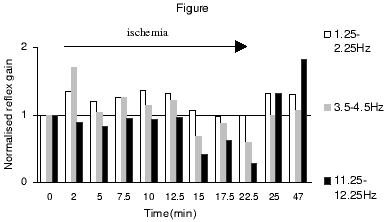
The aim of this study was to characterise the response of large and small muscle afferents to stretches over the low range of frequencies encountered during normal voluntary movement and to relate these changes to changes in joint stiffness. In 12 normal human volunteers, we elicited tonic stretch reflexes (TSR) in the contracting (10% of maximum voluntary contraction (MVC)) ankle dorsi-flexors using a complex 2min stretch sequence. The sequence contained frequencies spanning 0.1-14 Hz. The stretch was digitally generated and applied by a position-controlled servomotor before, during and after 24.5 min of ischemia produced by inflation of a cuff above the knee. The surface electromyography (EMG), joint angle and resistive torque records were analogue low-pass filtered (400 Hz) and digitised at 1000Hz. Reflex gain and coherence were computed by correlating the rectified and low-pass filtered EMG signals with the record of joint angle. (Matlab V6, Mathworks, USA).

The figure shows relative changes in TSR gain before (time=0), during (2-22.5min) and after (25-47min) ischemia for 3 representative frequency ranges. The gain of the reflex response to the lowest frequencies increased in early ischemia (at 2, 5, 7.5, 10 & 12.5 min) but not significantly (ANOVA, P>0.05) in comparison to control values (time=0). The gain of the middle frequency range increased significantly at 2 min of ischemia (ANOVA, P =0.03) and then declined during 15 - 22.5 min. The high frequency gain was most sensitive to ischemia. It tended to decline 2 min after cuff inflation and remained significantly decreased at 15 and 22.5 min (ANOVA, P<0.05, P<0.01) by about 70% of the control value. The high frequency gain showed significant recovery at 0.5 and 22.5 min after cuff deflation (ANOVA, P=0.002, P=0.003) compared with the last ischemic TSR value.
The resonant frequency (RF) of the ankle joint, calculated from the resistive torque data, increased in a linear manner with contraction of the ankle dorsi-flexors up to 20% of MVC (linear regression analysis, P<0.00001) (rest=7.07+1.15 Hz). The RF tended to decrease slightly during ischemia. However, the change was significant only at 2 min (ANOVA, P=.04) compared to the control value.
We conclude that both ischemia-sensitive and ischemia-resistant muscle afferents contribute to the stretch response and that they can be distinguished partly through their different stretch frequency responses. The evidence for an association between muscle reflex effects and effects on mechanical joint stiffness was not strong under the experimental conditions.